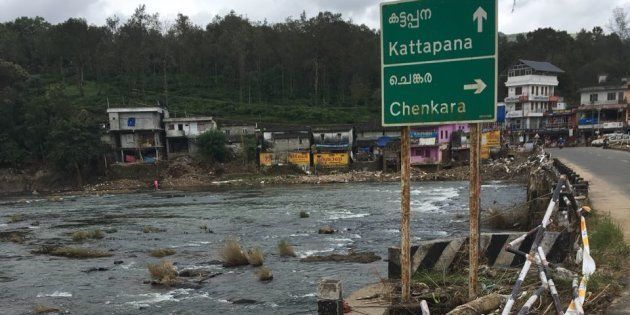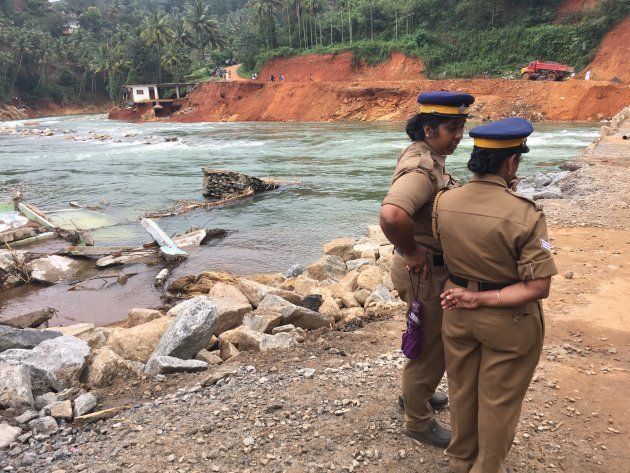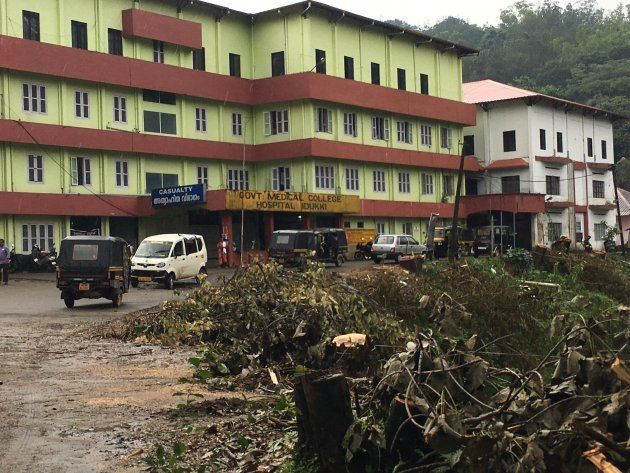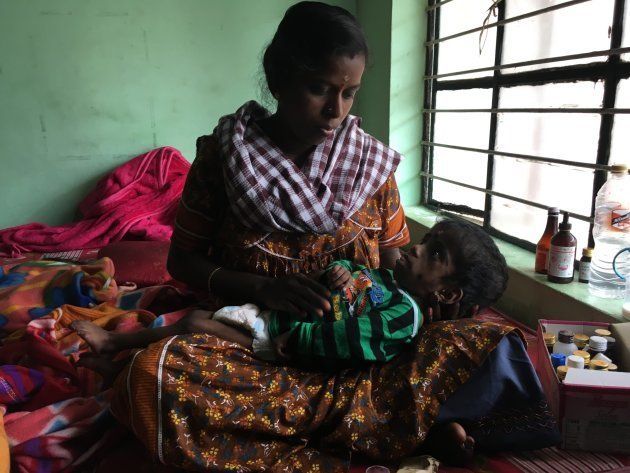
Idukki, KERALA —A month after unprecedented floods devastated Kerala, it is still unclear how the state will rebuild what it lost, and more importantly, how the redevelopment will be financed.
In the highland district of Idukki, where the Periyar river raged all through August, every bend in the road still bears gaping landslide wounds and every bridge shows signs of breach. The sun is finally out but with the North-east monsoon coming, reconstruction is still a long way away.
"We're still in the stage of assessing damages, clearing roads, making financial payments to people returning from camps and compiling reports on just how much assistance we need," said a section clerk at the District Emergency Operations Centre who did not want to be identified. Many like him didn't visit their homes for days after the Cheruthoni dam's shutters were opened. Rehabilitation operations are still going on.
By his calculations, landslides, rain and flooding have damaged almost 6,000 homes just in Idukki. 59 people died in the district, and thousands of hectares of agricultural land and perfectly manicured plantations have sustained damage, the loss valued at over Rs 70 crore. The cost to biodiversity in the tourist hotspot was yet to be quantified.
As extreme weather events increase in frequency, the Kerala floods point to a key tension in India's disaster relief framework: Disasters are localised, and relief work is best managed locally. Yet, funding for disaster management and mitigation is heavily centralised, and at times easily diverted to other budget heads.
GST Versus Disaster Relief
In November 2016, Prime Minister Narendra Modi unveiled his widely-hailed 10-Point Agenda at the Asian Ministerial Conference on Disaster Risk Reduction, where he stated that all of India's expenditure must take "risk considerations" into account.
In May the same year, the Supreme Court, ruling on a petition on drought relief, had chided the government for not setting up the National Disaster Mitigation Fund (NDMF) ten years after the Disaster Management Act came into force, and directed that it be set up in three months.
Within hours of the judgement, India's finance minister Arun Jaitley disputed the court's recommendation, which had already been made earlier by a standing committee on disaster preparedness, and by the CAG in 2013, besides being enshrined in the Disaster Management Act.
"Step by step, brick by brick, the edifice of India's legislature is being destroyed," Jaitley said in Parliament. "We have the National Disaster Response Fund (NDRF) and the State Disaster Response Fund (SDRF) and now we are being asked to create a third fund!"
In the Rajya Sabha, Kiren Rijiju, Minister of State for Home Affairs, said the government didn't feel the need to create a National Disaster Mitigation Fund and that there were "sufficient schemes to take care of mitigation measures in different projects".
While the NDMF remained in limbo, the NDRF was imperilled by the introduction of the Goods and Services Tax (GST).

In a report tabled in Parliament in 2015, India's Fourteenth Finance Commission had warned that the GST could subsume the cesses that contribute to the National Calamity Contingency Fund (NCCF), which seeds the NDRF. It recommended that "the Union Government should consider ensuring an assured source of funding for the NDRF" and that it should explore CSR funds as a possible source.
When the GST and Taxation Laws (Amendment) Act were introduced in 2017, cesses imposed on all products—except tobacco, cigarettes and petroleum crude—that contribute to the NCCF were lifted, leading to a dip in collections from Rs 6,450 crore in 2016-17 to Rs 3,660 crore in 2017-18.
India's unique coal cess and National Clean Energy Fund were also dissolved and a massive corpus of Rs 57,000 crore was diverted to subsidising the anticipated losses states would suffer from implementing the GST. The Clean Energy Fund—meant for climate change R&D— was also a source for the National Adaptation Fund and the National Climate Action Plan. In their place, a GST compensation cess was introduced, which collects the same levy—Rs 400 per tonne—on all coal mined and sold within the country, in addition to other products. In 2017, Rs 61,331 crore was collected as part of the GST compensation cess.
"Where does the buck stop?" asked Justice Madan B. Lokur, in his ruling in the Swaraj Abhiyan drought relief case, trying to make sense of why states and the centre both failed to declare a drought and prepare for more like it. "The Union of India has certainly to maintain a delicate and fine balance between federalism and its constitutional responsibility, and that it must do, otherwise it is ultimately the common person who will suffer and be in distress because of a situation not of his or her making."
NDRF and SDRF
Questions of funding aside, it isn't easy for states to access the NDRF, and its state counterpart, the SDRF.
SDRFs get funding from the centre depending on their vulnerability, the money they raise themselves and how much they can spend. For certain states, classified as disaster-prone at the Union's discretion, the centre foots 90% of the tab, but most states, including Kerala, must contribute 25% to their SDRF while the centre funds 75%. The 14th Finance Commission's recommendation that the 90:10 ratio extend to all states has not seen any uptake. Between 2014 and 2018, the top four states that saw the highest SDRF allocations were Maharashtra, Rajasthan, Madhya Pradesh and Gujarat, all led by the Bharatiya Janata Party. Goa, Kerala and nearly all of the special category states lie at the bottom of the pool—appearing that the more states spend, the more their allocations.
What and how much SDRFs can spend on in the name of disaster relief is fairly constrained. Restoration and reconstruction, for instance, is not covered under SDRF or NDRF, but must come from states' own plan funds.
States can receive support from the NDRF outside of their allocations only for "natural calamities of cyclone, drought, earthquake, fire, flood, tsunami, hailstorm, landslide, avalanche, cloud burst, pest attack, frost and cold wave considered to be of severe nature by Government of India".

For a given calamity, state governments must submit a memorandum to the Ministry of Home Affairs, a central team must make an on-the-spot assessment, and its recommendations must be approved by a National Executive Committee, after which a high-level committee—which includes the Home Minister, Finance Minister, Agriculture Minister and the Vice-Chairman of NITI Aayog—can approve the amount of immediate relief to be released.
For local disasters that don't fall within the national definition, states can use 10% of their own disaster relief fund—provided these are notified as state-specific disasters, with clear norms and guidelines on how to manage them.
In Kerala, for instance, "soil piping"—a phenomenon where underground tunnels are formed due to soil erosion—was classified as a state-specific hazard after a study by the National Centre for Earth Science Studies found that districts in the Western Ghats, Idukki included, were vulnerable to soil piping and landslides. While the study warned of extensive damages to infrastructure in case heavy rain struck the steep laterite slopes in the Ghats, Kerala can only use 10% of its fund for relief.
This top-down approach and limitations on spending—requiring the approval and inspection of multiple Central committees—expose even the most urgent relief efforts to political bias and time lag.
Anomalies abound: Assam, for instance, received no additional assistance from the centre between 2014 and 2018, despite facing floods every year; Jammu and Kashmir received just over Rs 43 crore from the NDRF in 2014-15 when it faced its worst floods ever.
READ: Outdated Guidelines, Faulty Weather Reports Worsened Crisis In Kerala. Here's What India Can Learn
It's little surprise, then, that more states have taken to raising relief from citizens and private entities.
"The state has single-handedly collected around Rs 107 crore in the Chief Minister's Distress Relief Fund for giving assistance to Ockhi victims," says a memorandum from the Kerala government in May 2018, after stating that its request for Rs 7,340.45 crore from the centre for "recovery, rehabilitation and reconstruction" was denied.
Even after the most recent floods, people across the world donated to the Chief Minister's fund, and the state's finance minister Thomas Isaac said on 30 August that contributions had crossed Rs 1,000 crore.
International Funding
"India's policy on asking for international finance is inconsistent. When the international community offers to support rebuilding or relief, we're reluctant to accept any aid," said Harjeet Singh, global lead on climate change for ActionAid and an international expert on climate adaptation and loss and damage. "Meanwhile, on climate change, India's main fight at the UN level is almost exclusively about finance."
India, in its Nationally Determined Contribution to the Paris Agreement, estimated it would need $2.5 trillion to cover the cost of climate change actions between 2015 and 2030, which includes loss and damage such as what happened in Kerala. A 2014 study by the Asian Development Bank estimated economic damage and losses in India from climate change to be around 1.8% of its GDP annually by 2050, while it's already losing $9-10 billion every year to extreme weather events.
The Modi government's decision to turn down aid offered by the UAE is currently being debated in court. India's National Disaster Management Plan, unveiled in 2016, states that "if the national government of another country voluntarily offers assistance as a goodwill gesture in solidarity with the disaster victims, the Central Government may accept the offer".
Interestingly, India's Tenth Five Year Plan allowed state and central governments to accept funding from multilateral funding agencies to increase their disaster preparedness. Between 2002 and 2012, the United Nations Development Programme and Ministry of Home Affairs partnered on two disaster risk management programmes. In 2015, the second phase of India's National Cyclone Risk Mitigation Project was approved by the Modi government, with World Bank assistance amounting to Rs 1,881.10 crore, and the rest being contributed by Goa, Gujarat, Karnataka, Kerala, Maharashtra and West Bengal.
India's participation at international forums, such as the UN's Warsaw International Mechanism for Loss and Damage, has been found severely wanting. Issues such as climate-induced displacement and migration have seen little or no expert engagement, with the government reserving its best negotiators for sparring with developed nations that control the purse strings.
"When you don't engage, it's not just a question of money: there's an immense amount of knowledge being generated—from understanding attribution science to learning to how manage and adapt to deal with disasters better, in a warming world. India can contribute a lot but it can also learn from the global experience on new climate challenges," said Singh. "Look at Kerala and you will see that every single sector is climate sensitive—agriculture, forestry, tourism and yet we have not recognised the massive challenge before us and how inadequate our efforts to cope or adapt have been," he added.

Meanwhile, in a forest department dormitory in the village of Vellappara, just minutes away from the Idukki dam, Samitha Suresh waits with 25 other families from her colony of Gandhinagar. Nearly everyone here has lost family members, houses and livelihoods. The dormitory has become a de-facto home.
"We're getting everything we need here—but who will give us back our land, our home, our lives? When can we go back?," she asks.